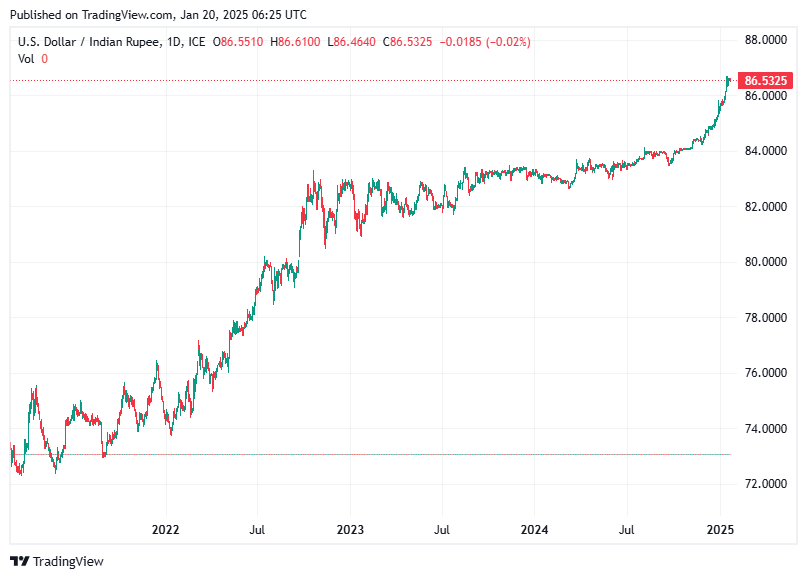How Currency Movements Affect Your Expected Returns?
How the Rupee's Value Affects Your Investments in India
Hello, subscribers!
I hope you are fine with your family.
Welcome back to another weekly edition of Growth Inshots. Whether you're diving into the latest finance trends or looking for fresh insights, we're here to break it down in the simplest way possible.
Please note, this is not a recommendation, but simply for educational purposes.
Let's jump right in
As an investor, you might think that the stock market and company performance are the only things that matter when calculating your returns. But here's the thing—there’s another silent player in the game, and that’s the Indian Rupee (INR).
The value of the rupee can have a huge impact on the returns you get from your investments, and it’s not something you can afford to ignore.
Let’s dive into how the currency movement shapes your expected returns in India.
The Current Situation
As of January 20, 2025, the Indian Rupee is trading at around 86.53 per US Dollar (Reuters). To put that into perspective, it means that for every dollar you exchange, you get about 86.53 rupees. You might not think much about it, but this small change can make a big difference when it comes to your investments.
When you think about investing, you probably focus on the company’s performance, market conditions, or economic trends. However, one important factor that affects the return on your investment is something many people overlook—the currency.
For investors in India, changes in the value of the Indian Rupee (INR) can directly impact the cost of equity, which in turn affects the returns you expect from your investments.
How Currency Affects Investment Returns
Let’s say you're investing in a company that has operations outside India or earns revenue in foreign currencies.
If the rupee weakens against a foreign currency, the company’s future cash flows in that currency could become more volatile. This increased uncertainty and risk make investors demand a higher return, pushing up the cost of equity.
Essentially, investors require compensation for the added risk they’re taking on.
For instance,
if the rupee weakens against the US dollar, an Indian company exporting goods to the US might see an increase in its revenue when converted into rupees.
However, the uncertainty about how much revenue the company will make in the future—thanks to exchange rate fluctuations—makes the investment riskier. This prompts investors to demand a higher return, which, in turn, increases the company’s cost of equity.
On the other hand, when the rupee strengthens, the opposite occurs. The company’s revenue from foreign markets might be lower when converted back into rupees.
However, the overall risk associated with the investment decreases. Investors perceive the company as less risky, and as a result, they may not demand as high a return on their investment, leading to a lower cost of equity.
Impact on Costs and Risks
If the rupee strengthens, companies that import raw materials or have foreign debt will face lower costs for their imports or servicing of foreign debt. This reduces the company’s financial risk, which can lower the cost of equity because investors perceive the company as being less risky.
However, if the rupee weakens, the company will face higher import costs and foreign debt repayments, which will increase financial risk and raise the cost of equity.
Currency fluctuations can also sway investor sentiment. A weakened rupee may make the Indian market appear riskier, often due to inflation concerns or broader macroeconomic instability.
As a result, investors may demand higher returns, which increases the cost of equity. In contrast, a stronger rupee can signal economic stability, making investors feel more confident and possibly lowering the cost of equity.
Additionally, if a company raises funds in international capital markets, a weaker rupee could make foreign investors more cautious. They might require a higher return to compensate for the currency risk. On the other hand, a stronger rupee could attract foreign investors, potentially lowering the cost of equity as the company becomes a less risky investment.
How Does This Affect Your Expected Returns?
Currency exchange rates can influence your expected returns in several ways:
Holding Export-Oriented Stocks: A weaker rupee might boost profits, meaning better returns.
Holding Import-Heavy or Foreign-Listed Assets: A weak rupee can erode profits, leading to lower returns when converted into INR.
Investing in Foreign Markets: A weaker rupee might reduce returns when converting foreign returns back into rupees.
These fluctuations directly impact what you’re pocketing from your investments, so it’s crucial to stay on top of them.
So,
The rupee is not just a number on the currency exchange chart—it’s a powerful factor that impacts the value of your investments. Whether the rupee is strong or weak, it affects the profit margins of companies you’re invested in and the value of your foreign assets.
As an investor in India, you need to stay alert. By understanding how the rupee is moving, you can make more informed decisions about where to park your money.
So, the next time the rupee fluctuates, remember: it’s not just a currency—it’s a tool that can either make or break your expected returns.
Hope this insight will be insightful for you.
Thanks for reading Growth Inshots! Subscribe for free to receive new posts and support my work.
Signing off




